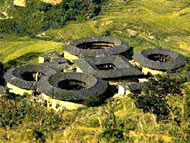 The State Bureau of Cultural Relics has applied to the United Nations Educational, Scientific and Cultural Organization (UNESCO) to place earth buildings, (tulou in Chinese) in East China's Fujian Province, on the World Cultural Heritage List.
The State Bureau of Cultural Relics has applied to the United Nations Educational, Scientific and Cultural Organization (UNESCO) to place earth buildings, (tulou in Chinese) in East China's Fujian Province, on the World Cultural Heritage List.
The UN experts will make an appraisal in the spring of next year and will make their decision in June 2003.
Scattered over a remote mountainous area, most of the 20,000 earth buildings are well-preserved. These huge buildings, which resemble fortresses and are usually as high as 5-storey-buildings, are called earth buildings because of their height and their strong, outer shell which is made up of earth. The walls, often propped up by a frame of bamboo and wood chips, are made of earth, sand and limestone.
Regarded by architects as the cream of Chinese traditional residential architecture, tulou first appeared about 1,200 years ago, and were mostly completed in the Ming (1368-1644) and Qing (1644-1911) dynasties.
They were built and inhabited by the Hakka people - a group belonging to the Han family who can trace their ancestors back more than 1,500 years to central and north China.
During the hundreds of years of migration, the Hakka people tried to maintain their own culture and way of life, keeping their own unique dialect, custom and cuisine.
They built the earth complexes to guard against invasion from local bandits and to protect their children from the influence of local communities.
All the families of a Hakka clan lived together in an enclosed earth building.
The tulou has various functions for people's everyday lives, and has enough space for people to perform activities, including entertainment, education and defense.
To meet the application, the local government will need to make more efforts to improve and protect these buildings, Ming Mei, director of the Fujian Tourism Bureau, said at the current festival.
(China Daily 10/06/2001)
